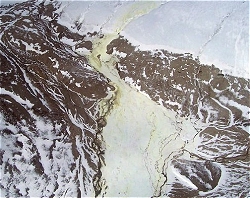
May Editorial
Sulphur deposits in the Borup Fiord Pass - clues to extra-terrestial life?

May Editorial
Sulphur deposits in the Borup Fiord Pass - clues to extra-terrestial life?
|
Borup Pass spring on Ellesmere Island in Northern Canada is like no other place on Earth. It is the only place known where sulphur is deposited directly over ice by a spring which has the sulphur as a natural component. This spring is in the Borup Fiord Pass - a glacier-carved valley. The hydrogen sulphide gas in the water is converted into either sulphur (the most common material in the deposit), or gypsum. This seeps through cracks in the ice and is deposited on the surface. The chemical reactions which convert hydrogen sulphide into sulphur are complex and most often require the help of bacteria. So since there is sulphur over the icecap, this strongly suggests that life forms are present there as well.
|
To find out more about the icecap sulphur deposits, researchers from the University of Calgary organised a two week expedition in 2006. The team travelled to this remote part of Canada and collected samples of the supraglacial deposits. These samples were then analysed using X-ray diffraction (XRD) measurements and spectrometric analysis at the visible-near infrared (VIS-NIR) range, 0.4–2.5 µm. This not only allowed the scientists to study the chemical composition of the deposits but also to get a reliable reading of the spectra which could be used as a 'spectral fingerprint' when comparing the spectra with other samples. | |
|
But the scientists did not stop there. They were also interested in whether the glacial deposits of sulphur in the Borup Pass could be seen and analysed from space. In collaboration with researchers from NASA’s Jet Propulsion Laboratory in California, the team utilised data from Hyperion - a hyperspectral visible/infrared spectrometer aboard the NASA's Earth Observing 1 spacecraft (EO-1). Analysis of the data from the spacecraft was collected over a period of few months, and the data showed that the sulphur deposits in the Borup Fiord Pass are stable. They also showed that the readings of sulphur deposits obtained from Hyperion are comparable to those obtained in the laboratory. By why go into all that trouble to analyse the Borup Pass deposits? And way was the space analysis important? Study of these deposits are important because the processes which take place in this remote part of Canada may give us a clue as to what is happening in other parts of the Universe. In particular, Europa is of immediate interest. This small moon orbiting Jupiter is covered in ice, but most planetary scientists believe that below the frozen surface there is liquid water kept warm by tidally-generated heat. When Galileo (an unmanned spacecraft sent by NASA in 1989 to study Jupiter and its moons) sent back data, the researchers spotted dark, non-ice deposits on Europa’s icy surface. But no-one knew what these dark deposits were. The Galileo space probe's spectrometers captured near-infrared signals from Europa — a 'spectral fingerprint' that could help in identifying these substances by comparing them to known spectra. In their recent publication Damhnait F. Gleeson et al. (1) showed that spectral data obtained from the Borup Pass have similarities to those of Europa's non-ice materials. Although the data obtained by Galileo cannot be used as direct proof, NASA believes that a future orbiting sensor like Hyperion could be used to identify chemicals in Europa’s non-ice deposits. If these are sulphur deposits, and they have been created in the same way as the deposits in Borup pass, the Galileo spacecraft may have found signs of extraterrestrial microbial life. Reference:
| |
| _______________________________ | ||||
| Home | | | Shopping | | | Database |
© Biscuit Software 2004-2015
All rights reserved